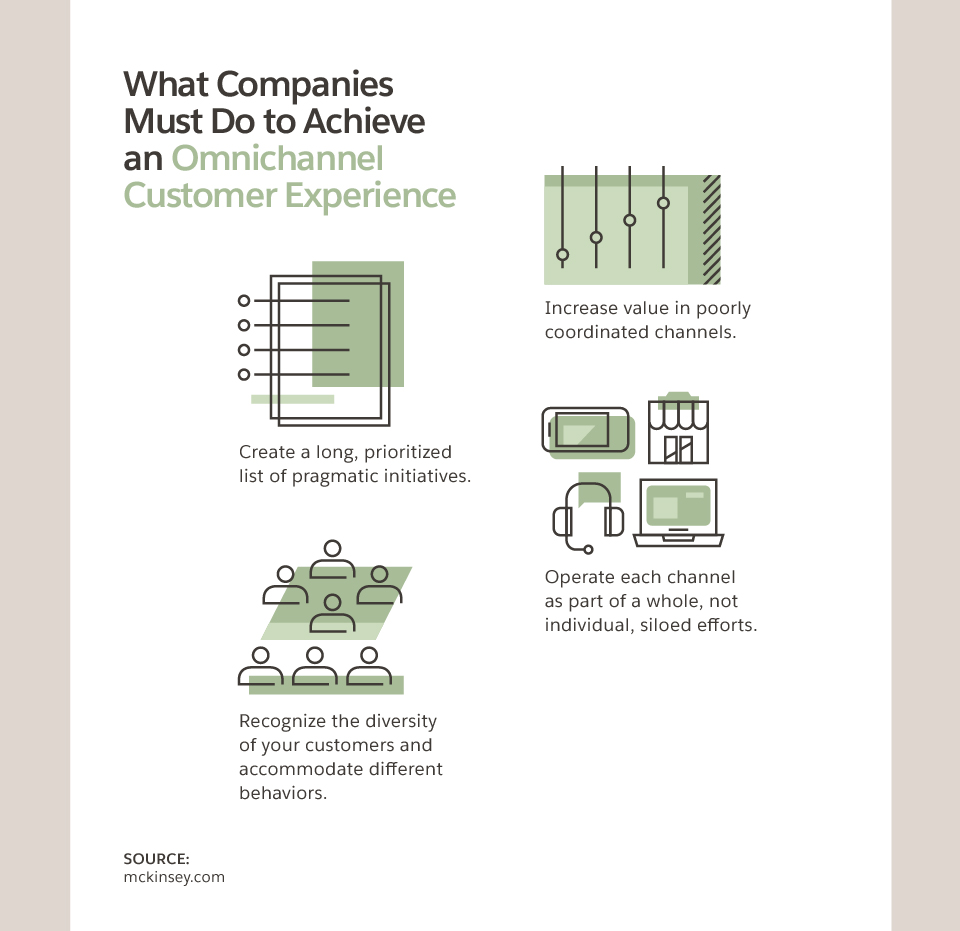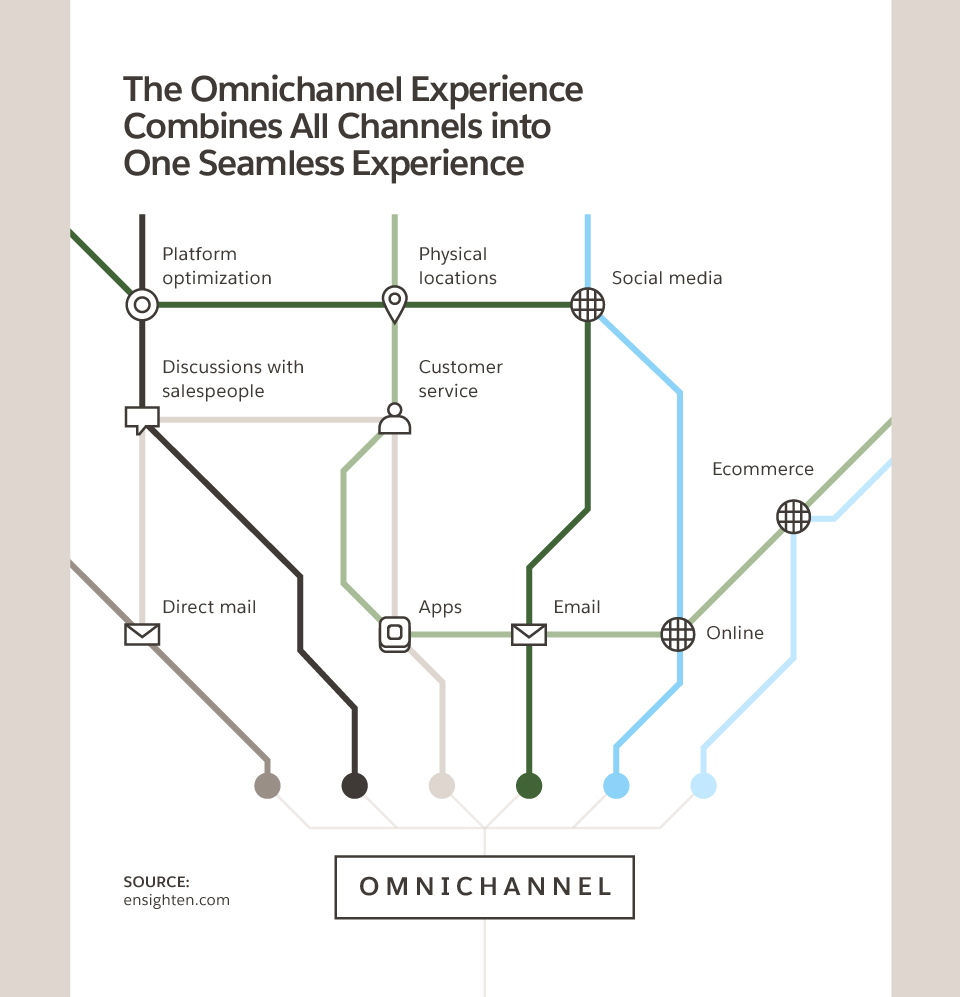From a customer’s standpoint, every interaction with your company should be part of a singular experience — not a siloed, repetitive one. In fact, a smooth, seamless connection between the online and the offline worlds can provide a lifeline. For example, imagine you have to book a plane ticket just a few hours before hopping on a plane. To beat the clock and make your flight may require a few tweets, a visit to the airline’s website, a call to the airline’s customer service team and a quick check-in once you are at the gate.
When this kind of interaction happens seamlessly, and the intersections of the online and offline channels work together smoothly, your needs are met quickly and painlessly (and you are not left behind at the terminal). This is the omni-channel customer experience.
Defining omni-channel customer experiences
Multichannel is when
multiple marketing and service channels work independently to enhance the customer experience. When these channels work with one another, that’s when multichannel evolves into
omni-channel. Omni-channel results in a single, seamless interaction with consumers across all channels, both online and offline. This can include all touchpoints in the customer lifecycle — websites, social media, live chats, follow-up emails, phone calls and in-person assistance on the sales floor.
Look at a bank. Financial institutions should be available to assist you any time of the day or night over multiple channels. The goal is to do so without your having to repeat yourself because the institutions have documented, collected and stored all the information about your offline and online inquiries. For its part, the bank can effortlessly upsell services appropriately because it has the history of your interactions with the bank.
Thanks to implementing an omni-channel customer experience, McKinsey & Company increased a regional bank’s product sales by
more than 25% in six months. The bank tightened the loose ends between its digital and traditional channels and made the user’s experience as seamless as possible.
 Why does omni-channel matter?
Why does omni-channel matter?
Which of these two options would you choose: a product from a company that pulls your personal data from your previous online experiences and doesn’t ask too many questions, or something from a company that asks you to spend time filling out multiple forms? You likely want to do business with the company that knows what it’s doing and uses the information it has already collected from you to make your life easier.
In fact,
70% of customers “say connected processes are very important to win their business (such as seamless handoffs between departments and channels, or contextualized engagement based on earlier interactions).” Furthermore,
over 80% of customers are willing to give a company relevant personal information to bridge the connection between their online and in-person experiences.
See also: A Management Guide to Omni-Channel
Successful omni-channel implementation offers myriad ways to prevent disconnected departments and processes from happening. It supplies representatives from all your departments with all the company’s information about a specific customer. For instance, a customer began messaging through your website’s integrated chatbot about an issue, then decided to contact your call center. As customers switch from one channel to another, they expect (or at least hope) they won’t have to re-explain what they need.
The omni-channel experience focuses on the overall customer experience, making it smoother, more consistent and highly personalized for customers.
Build a better customer experience with omni-channel integration
Even though the main idea behind the omni-channel experience is fairly easy to understand, companies are still figuring out how to manage it correctly. Many companies can handle the multichannel experience, but industry leaders are investing in omni-channel as a part of their commitment to a great customer experience.
Let’s review some ways to make the processes work like clockwork, as well as what to do when integrating channels for an omni-channel customer experience.
 1. Understand your customers' behavioral patterns
1. Understand your customers' behavioral patterns
This is where everything begins. Because the omni-channel experience is all about creating a flawless customer journey, understanding this journey from the very beginning is crucial.
Gather data.
Gather all the data you have about your customers, including how they prefer to interact with your brand. If you have a CRM system, that’s your starting point. Check your various analytics tools, too, to learn more about your customers’ communication preferences when they reach out to your support team or decide to purchase your products.
Your data, analytics and key performance indicators (KPIs) are among the most important tools your business can use to make the customer experience as pleasant as possible. Search engine optimization (SEO), search engine marketing (SEM) and email campaigns all offer rich insights into both potential and current customers. “
Ecommerce analytics must evolve to track shoppers wherever they may be, whether they are purchasing a product on Instagram, discovering a brand on their phone or cashing in a gift card at a pop-up shop.” As omni-channel becomes more commonplace, well-organized and optimized data will provide the competitive edge.
Use surveys.
Research the issues that customers come across through short surveys. One method is to enlist the help of your sales and support teams. Those teams are at the forefront of your company, directly represent your brand and communicate with your clients daily. A second method is to weave surveys into your online experiences. For example, when a user performs a specific action on your website, have a brief customer satisfaction survey pop up. These triggered questionnaires can provide valuable feedback.
Define segments.
Always keep in mind your audience segmentation. Different groups of customers have different needs, and those needs should help you
define your user personas. You can segment your users by the products they use, the frequency of their purchases or their customer lifetime value (CLV). A well-implemented omni-channel user experience can increase a client’s retention rate, and therefore potentially CLV.
Interview customers.
Finally, talk to your customers. Do they feel like something’s missing? What would they like to see in your product line? Is there something your company does particularly well? If you can, ask them a quick question each time they shop with you. For example, after completing your data analysis, your ecommerce store may learn that customers prefer to pick up their order at a store instead of waiting for an item to be delivered. Some businesses have seen increases in their sales by giving their customers the option to track their orders and sending them notifications. These improvements enhance their shopping experience and keep customers coming back.
2. Create your own omni-channel universe
After defining your customer journey, generate ideas on how to make the journey more coherent. How can your representatives jump from one channel to another, without data loss, in the most convenient way for the customer? Your customers come to you from various channels, but their personal details should be saved and accessible throughout your data management system and CRM platform. This means that all of the channels and technology you use in your business processes do not operate in silos; they should be synchronized, integrated and able to work together to complete any missing pieces of information. By fine-tuning this process of interchannel and interdepartmental cooperation, you will likely generate more revenue.
Because social media is an extension of many people’s lives, many ecommerce sites integrate their services with social platforms. When it comes to online shopping, Instagram and Pinterest reign supreme; however, each industry has its own dominant social network. This means the omni-channel universe extends far beyond your company’s data and platforms and must include social media.
 3. Measure your customer experience data
3. Measure your customer experience data
After setting up all the necessary processes, make sure your omni-channel experience is performing as planned. Data and analytics give you the ability to view and learn the results of your efforts. To measure your omni-channel customer experience from a subjective point of view, collect feedback from your customers on key points throughout their journey with your brand. It can be through a call center, over an online chat, by a quick online survey or on a social media page.
See also: How to Win the Retention Game
Proper management and organization of the data you collect will help you tweak your efforts and put you on the right track to a better omni-channel experience. Research, analysis and data-backed action provide a better understanding of your customers’ needs and expectations.
Conclusion
An omni-channel customer experience helps companies offer a personalized approach through a smooth, inviting customer journey that drives repeat purchases and loyalty. The process is worth it. Take these steps to improve your chances of achieving a true omni-channel customer experience, and, as a result, you’ll have happier customers who are glad to give you business. Thanks to your efforts to improve the customer experience, your company will see increased revenue and growth.
 Why does omni-channel matter?
Which of these two options would you choose: a product from a company that pulls your personal data from your previous online experiences and doesn’t ask too many questions, or something from a company that asks you to spend time filling out multiple forms? You likely want to do business with the company that knows what it’s doing and uses the information it has already collected from you to make your life easier.
In fact, 70% of customers “say connected processes are very important to win their business (such as seamless handoffs between departments and channels, or contextualized engagement based on earlier interactions).” Furthermore, over 80% of customers are willing to give a company relevant personal information to bridge the connection between their online and in-person experiences.
See also: A Management Guide to Omni-Channel
Successful omni-channel implementation offers myriad ways to prevent disconnected departments and processes from happening. It supplies representatives from all your departments with all the company’s information about a specific customer. For instance, a customer began messaging through your website’s integrated chatbot about an issue, then decided to contact your call center. As customers switch from one channel to another, they expect (or at least hope) they won’t have to re-explain what they need.
The omni-channel experience focuses on the overall customer experience, making it smoother, more consistent and highly personalized for customers.
Build a better customer experience with omni-channel integration
Even though the main idea behind the omni-channel experience is fairly easy to understand, companies are still figuring out how to manage it correctly. Many companies can handle the multichannel experience, but industry leaders are investing in omni-channel as a part of their commitment to a great customer experience.
Let’s review some ways to make the processes work like clockwork, as well as what to do when integrating channels for an omni-channel customer experience.
Why does omni-channel matter?
Which of these two options would you choose: a product from a company that pulls your personal data from your previous online experiences and doesn’t ask too many questions, or something from a company that asks you to spend time filling out multiple forms? You likely want to do business with the company that knows what it’s doing and uses the information it has already collected from you to make your life easier.
In fact, 70% of customers “say connected processes are very important to win their business (such as seamless handoffs between departments and channels, or contextualized engagement based on earlier interactions).” Furthermore, over 80% of customers are willing to give a company relevant personal information to bridge the connection between their online and in-person experiences.
See also: A Management Guide to Omni-Channel
Successful omni-channel implementation offers myriad ways to prevent disconnected departments and processes from happening. It supplies representatives from all your departments with all the company’s information about a specific customer. For instance, a customer began messaging through your website’s integrated chatbot about an issue, then decided to contact your call center. As customers switch from one channel to another, they expect (or at least hope) they won’t have to re-explain what they need.
The omni-channel experience focuses on the overall customer experience, making it smoother, more consistent and highly personalized for customers.
Build a better customer experience with omni-channel integration
Even though the main idea behind the omni-channel experience is fairly easy to understand, companies are still figuring out how to manage it correctly. Many companies can handle the multichannel experience, but industry leaders are investing in omni-channel as a part of their commitment to a great customer experience.
Let’s review some ways to make the processes work like clockwork, as well as what to do when integrating channels for an omni-channel customer experience.
 1. Understand your customers' behavioral patterns
This is where everything begins. Because the omni-channel experience is all about creating a flawless customer journey, understanding this journey from the very beginning is crucial.
Gather data.
Gather all the data you have about your customers, including how they prefer to interact with your brand. If you have a CRM system, that’s your starting point. Check your various analytics tools, too, to learn more about your customers’ communication preferences when they reach out to your support team or decide to purchase your products.
Your data, analytics and key performance indicators (KPIs) are among the most important tools your business can use to make the customer experience as pleasant as possible. Search engine optimization (SEO), search engine marketing (SEM) and email campaigns all offer rich insights into both potential and current customers. “Ecommerce analytics must evolve to track shoppers wherever they may be, whether they are purchasing a product on Instagram, discovering a brand on their phone or cashing in a gift card at a pop-up shop.” As omni-channel becomes more commonplace, well-organized and optimized data will provide the competitive edge.
Use surveys.
Research the issues that customers come across through short surveys. One method is to enlist the help of your sales and support teams. Those teams are at the forefront of your company, directly represent your brand and communicate with your clients daily. A second method is to weave surveys into your online experiences. For example, when a user performs a specific action on your website, have a brief customer satisfaction survey pop up. These triggered questionnaires can provide valuable feedback.
Define segments.
Always keep in mind your audience segmentation. Different groups of customers have different needs, and those needs should help you define your user personas. You can segment your users by the products they use, the frequency of their purchases or their customer lifetime value (CLV). A well-implemented omni-channel user experience can increase a client’s retention rate, and therefore potentially CLV.
Interview customers.
Finally, talk to your customers. Do they feel like something’s missing? What would they like to see in your product line? Is there something your company does particularly well? If you can, ask them a quick question each time they shop with you. For example, after completing your data analysis, your ecommerce store may learn that customers prefer to pick up their order at a store instead of waiting for an item to be delivered. Some businesses have seen increases in their sales by giving their customers the option to track their orders and sending them notifications. These improvements enhance their shopping experience and keep customers coming back.
2. Create your own omni-channel universe
After defining your customer journey, generate ideas on how to make the journey more coherent. How can your representatives jump from one channel to another, without data loss, in the most convenient way for the customer? Your customers come to you from various channels, but their personal details should be saved and accessible throughout your data management system and CRM platform. This means that all of the channels and technology you use in your business processes do not operate in silos; they should be synchronized, integrated and able to work together to complete any missing pieces of information. By fine-tuning this process of interchannel and interdepartmental cooperation, you will likely generate more revenue.
Because social media is an extension of many people’s lives, many ecommerce sites integrate their services with social platforms. When it comes to online shopping, Instagram and Pinterest reign supreme; however, each industry has its own dominant social network. This means the omni-channel universe extends far beyond your company’s data and platforms and must include social media.
1. Understand your customers' behavioral patterns
This is where everything begins. Because the omni-channel experience is all about creating a flawless customer journey, understanding this journey from the very beginning is crucial.
Gather data.
Gather all the data you have about your customers, including how they prefer to interact with your brand. If you have a CRM system, that’s your starting point. Check your various analytics tools, too, to learn more about your customers’ communication preferences when they reach out to your support team or decide to purchase your products.
Your data, analytics and key performance indicators (KPIs) are among the most important tools your business can use to make the customer experience as pleasant as possible. Search engine optimization (SEO), search engine marketing (SEM) and email campaigns all offer rich insights into both potential and current customers. “Ecommerce analytics must evolve to track shoppers wherever they may be, whether they are purchasing a product on Instagram, discovering a brand on their phone or cashing in a gift card at a pop-up shop.” As omni-channel becomes more commonplace, well-organized and optimized data will provide the competitive edge.
Use surveys.
Research the issues that customers come across through short surveys. One method is to enlist the help of your sales and support teams. Those teams are at the forefront of your company, directly represent your brand and communicate with your clients daily. A second method is to weave surveys into your online experiences. For example, when a user performs a specific action on your website, have a brief customer satisfaction survey pop up. These triggered questionnaires can provide valuable feedback.
Define segments.
Always keep in mind your audience segmentation. Different groups of customers have different needs, and those needs should help you define your user personas. You can segment your users by the products they use, the frequency of their purchases or their customer lifetime value (CLV). A well-implemented omni-channel user experience can increase a client’s retention rate, and therefore potentially CLV.
Interview customers.
Finally, talk to your customers. Do they feel like something’s missing? What would they like to see in your product line? Is there something your company does particularly well? If you can, ask them a quick question each time they shop with you. For example, after completing your data analysis, your ecommerce store may learn that customers prefer to pick up their order at a store instead of waiting for an item to be delivered. Some businesses have seen increases in their sales by giving their customers the option to track their orders and sending them notifications. These improvements enhance their shopping experience and keep customers coming back.
2. Create your own omni-channel universe
After defining your customer journey, generate ideas on how to make the journey more coherent. How can your representatives jump from one channel to another, without data loss, in the most convenient way for the customer? Your customers come to you from various channels, but their personal details should be saved and accessible throughout your data management system and CRM platform. This means that all of the channels and technology you use in your business processes do not operate in silos; they should be synchronized, integrated and able to work together to complete any missing pieces of information. By fine-tuning this process of interchannel and interdepartmental cooperation, you will likely generate more revenue.
Because social media is an extension of many people’s lives, many ecommerce sites integrate their services with social platforms. When it comes to online shopping, Instagram and Pinterest reign supreme; however, each industry has its own dominant social network. This means the omni-channel universe extends far beyond your company’s data and platforms and must include social media.
 3. Measure your customer experience data
After setting up all the necessary processes, make sure your omni-channel experience is performing as planned. Data and analytics give you the ability to view and learn the results of your efforts. To measure your omni-channel customer experience from a subjective point of view, collect feedback from your customers on key points throughout their journey with your brand. It can be through a call center, over an online chat, by a quick online survey or on a social media page.
See also: How to Win the Retention Game
Proper management and organization of the data you collect will help you tweak your efforts and put you on the right track to a better omni-channel experience. Research, analysis and data-backed action provide a better understanding of your customers’ needs and expectations.
Conclusion
An omni-channel customer experience helps companies offer a personalized approach through a smooth, inviting customer journey that drives repeat purchases and loyalty. The process is worth it. Take these steps to improve your chances of achieving a true omni-channel customer experience, and, as a result, you’ll have happier customers who are glad to give you business. Thanks to your efforts to improve the customer experience, your company will see increased revenue and growth.
3. Measure your customer experience data
After setting up all the necessary processes, make sure your omni-channel experience is performing as planned. Data and analytics give you the ability to view and learn the results of your efforts. To measure your omni-channel customer experience from a subjective point of view, collect feedback from your customers on key points throughout their journey with your brand. It can be through a call center, over an online chat, by a quick online survey or on a social media page.
See also: How to Win the Retention Game
Proper management and organization of the data you collect will help you tweak your efforts and put you on the right track to a better omni-channel experience. Research, analysis and data-backed action provide a better understanding of your customers’ needs and expectations.
Conclusion
An omni-channel customer experience helps companies offer a personalized approach through a smooth, inviting customer journey that drives repeat purchases and loyalty. The process is worth it. Take these steps to improve your chances of achieving a true omni-channel customer experience, and, as a result, you’ll have happier customers who are glad to give you business. Thanks to your efforts to improve the customer experience, your company will see increased revenue and growth.






















